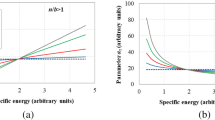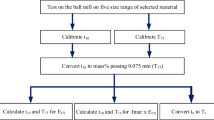Abstract
Tumbling mills using balls as grinding media are used extensively in the mining and cement industries to produce fine powders; however, it is well known that the process of size reduction is highly energy-intensive. For this reason, much of today’s comminution research is aimed at understanding grinding mechanisms, by estimating power draft and modeling milling circuits using the discrete element method (DEM). DEM predicts individual particle trajectories, the distribution of energy and contact forces at each collision, lifter wear and power draw. This paper presents a prediction of the discharge particle size distribution using three components, mass balance model (sometimes referred to as a population balance model, PBM), impact energy distribution of the mill obtained from the simulation of the charge motion using DEM and breakage characteristics of particles determined from drop-ball tests DEM simulation of the charge of a tumbling mill was done using the code MinProSim 1.0 to obtain impact spectra at different operative conditions. Then, thepopidation balance model (PBM), based on impact energy distribution, was used to predict the final particle size distribution in a batch mill and compared with experimental data. It is demonstrated that the DEM-PBM approach allows a reliable solution to predict particle size distribution for tumbling mills. Ideally, the model has to predict size distribution for any operational condition and feed characteristic; however, it has been shown that predictions include some degree of error.
Similar content being viewed by others
References
Buchholtz, V., Freund, J.A., and Poschel, T., 2000, “Molecular dynamics of comminution in ball mills,” The European Physical Journal, Vol. 16, pp. 169–182.
Cundall, P.A., and Strack, O.D.L., 1979, “A discrete numerical model for granular assemblies,” Geotechnique, 29, 47–65.
Datta, A., and Rajamani, R.K., 2002, “A direct approach of modeling batch grinding in ball mills using population balance principles and impact energy distribution,” International Journal of Mineral Processing, Vol. 64, pp. 181–200.
Kapur, P.C., Pande D., and Fuerstenau D.W., 1997, “Analysis of single particle breakage by impact grinding,” International Journal of Mineral Processing, Vol. 49, pp. 223–236.
King, R.P., and Bourgeois F., 1993, “A new conceptual model for ball milling,” Proceedings of the 18th International Mineral Processing Congress, Sydney, Australia, pp. 81–86.
Lira, B.B., and Kavetsky, A., 1990, “Application of a new model-based method of ball mill simulation and design,” Minerals Engineering, Vol. 3, pp. 149–163.
Luckie, P.T., and Austin, L.G., 1972, “A review introduction to the solution of the grinding equations by digital computation,” Mineral Science and Engineering, Vol. 4, pp. 24–51.
Mishra, B.K., 2003, “A review of computer simulation of tumbling mills by the discrete element method Part II - Practical applications,” International Journal of Mineral Processing, Vol. 71, pp. 95–112.
Mishra, B.K., and Rajamani, R.K., 1994, “Simulation of charge motion in ball mills. Part 1: experimental verifications,” International Journal of Mineral Processing, Vol. 40, pp. 171–186.
Narayanan, S.S., 1987, “Modeling the performance of industrial ball mills using single particle breakage data,” International Journal of Mineral Processing, Vol. 20, pp. 211–228.
Narayanan, S.S., and Whiten, W.J., 1988, “Particle breakage tests and its application to ball mill scale-up,” Transactions of The Institution of Mining and Metallurgy Section C, Vol. 97, C115–142.
Perez-Alonso, C., and Delgadillo, J.A., 2012, “Experimental validation of 2D DEM code by digital image analysis in tumbling mills,” Minerals Engineering, Vol. 25, pp. 20–27.
Powell M.S., and Morrison R.D., 2007, “The future of comminution modeling,” International Journal of Mineral Processing, Vol. 84, pp. 228–239.
Powell, M.S., and McBride, A.T., 2006, “What is required from DEM simulations to model breakage in mills,” Minerals Engineering, Vol. 19, pp. 1013–1021.
Rajamani, R.K., Agrawala, S., and Mishra, B.K., 1993, “Mill scale up: ball collision frequency and collision energy density in laboratory and plant-scale mills,” Proceedings of the 18th International Mineral Processing Congress, Sydney, Australia, pp. 103–109.
Reid, K.J., 1965, “A solution to the batch grinding equation,” Chemical Engineering Science, Vol. 20, No. 11, pp. 953–963.
Tavares, L.M., and Carvalho, R.M., 2009, “Modeling breakage rates of coarse particles in ball mills,” Minerals Engineering, Vol. 22, Issues 7–8, pp. 650–659.
Tavares, L.M., and King, R.P., 2002, “Modeling of particle fracture by repeated impacts using continuum damage mechanisms,” Powder Technology, Vol. 123, pp. 138–146.
Tugcan Tuzco, E., and Rajamani, R.K., 2011, “Modeling breakage rates in mills with impact energy spectra and ultra-fast load cell data,” Minerals Engineering, Vol. 24, pp. 252–260.
Wang, M.H., Yang R.Y., and Yu A.B., 2012, “DEM investigation of energy distribution and particle breakage in tumbling ball mills,” Powder Technology, Vol. 223, pp. 83–91.
Author information
Authors and Affiliations
Corresponding author
Additional information
Paper number MMP-12-054.
Discussion of this peer-reviewed and approved paper is invited and must be submitted to SME Publications Dept. prior to February 28, 2014.
Rights and permissions
About this article
Cite this article
Pérez-Alonso, C.A., Delgadillo, J.A. DEM-PBM approach to predicting particle size distribution in tumbling mills. Mining, Metallurgy & Exploration 30, 145–150 (2013). https://doi.org/10.1007/BF03402260
Received:
Accepted:
Published:
Issue Date:
DOI: https://doi.org/10.1007/BF03402260




